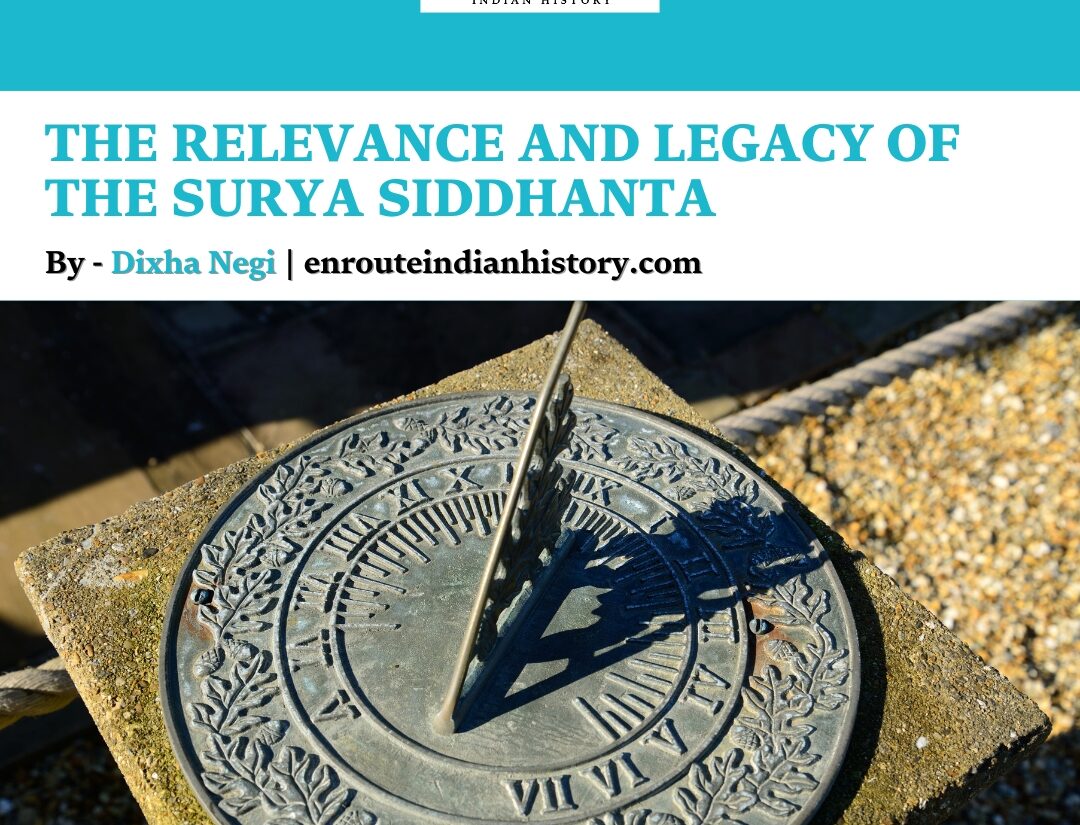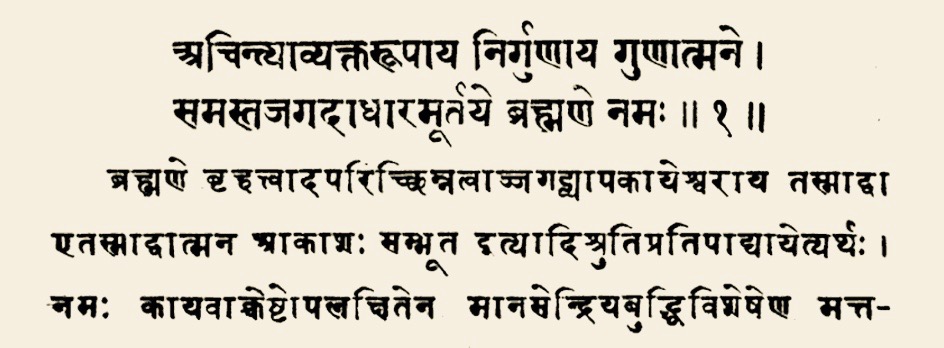The Relevance and Legacy of the Surya Siddhanta
- iamanoushkajain
- September 25, 2024

Various philosophers consider India to be the cradle of human civilization. Be it the mysteries of some ancient religious scriptures and practices or the advanced scientific development used by the people of the past, Ancient India boasts a rich cultural and scientific history.
There are countless books, articles and other pieces of evidence that highlight the nation’s remarkable achievements in the fields of both science and astronomy. Ancient Indian astronomy, in particular, is fascinating due to its lasting legacy on human knowledge and how well it lays down the understanding of the cosmos. Their ability to measure astronomical distances and explain celestial events demonstrates a unique scientific perspective beyond mere visual observation.
When it comes to grasping complex knowledge mentioned in ancient Indian scriptures, these texts can be categorized into two main categories, based on who wrote them.
- On one hand, we have texts by some of the most renowned philosophers throughout the history of Indian astronomy, such as Brahmagupta and Aryabhata.
- On the other hand, we have anonymous works called the Siddhantas, which do not have a claimed author.
There are various theories surrounding the reason behind the anonymity of such works. Some suggest that these were written as a divine revelation from gods to man. Others proposed that the anonymity was maintained as these authors saw or wanted to portray themselves as gods/messengers of the gods themselves. Either way, it identifies Siddhantas as some divine work, directly or indirectly related to God.
The term “Siddhanta” is a Sanskrit term and can be broken down into – ‘Siddh’ meaning ‘accomplished’ and ‘Anta’ meaning the ‘end.’ Initially a collection of 18 ancient astronomical Indian texts; over the years, only 5 of these texts remain, 13 of these being lost and probably destroyed. This fact is not surprising as such knowledge was mostly passed, from person to person and generation to generation, orally and thus wasn’t often written down. As a result, one may conclude many of such works that probably existed, were either forgotten or survived in bits and fragments.

A photo of the first verse of the first page of The Surya Siddhanta, written in praise of Lord Brahma, Lord Shiva and Lord Vishnu. (Credits: Wikipedia)
Talking about astronomy, it is impossible not to include or refer to the concept of time. These two concepts have been intertwined since the dawn of human civilization. The movement of the celestial bodies has practically served as an effective as tool for measuring time, for the ancient astrologers. It helps us track the age of people, animals, and objects. However, one must note that this time measurement is relative, not absolute.
Time has been fundamental in performing rituals, as stated in our Vedas. It has both philosophical and practical importance, at least in Indian cultures and I’m sure it holds for other cultures as well. Time and Astronomy, thus, have been an integral part of Indian life since the Vedic era, with beliefs like the rituals should be performed at a particular and specified time or else, they might not be as effective. One of the most influential texts that explore this relationship between time and astronomy is – Surya Siddhanta. The Surya Siddhanta acts like a guide to astronomy that explains different astronomical ideas and how to calculate them.
Surya Siddhanta is a Sanskrit word formed by two words – ‘Surya’ and ‘Siddhanta.’ ‘Surya’ is a Sanskrit word for ‘sun’ and is also used for the Hindu Sun god. ‘Siddhanta’, as discussed earlier, are ancient astronomical Indian texts that explore information about planetary positions, eclipses, timekeeping, and astrological concepts. According to mythology and popular belief, the Surya Siddhanta was supposedly given to Mayasura, Ravana’s father-in-law, by the sun god Surya.
As we know, mythology is a set of collections of stories, beliefs, and folklore. These stories are of cultural and symbolic importance that can be interpreted and understood on a deeper level. These stories have historical roots. The authorship and exact date of the original Surya Siddhanta remains a question of uncertainty till date. However, the earliest ‘known’ version dates back to the 4th or 5th century. It is believed to have been compiled or revised from an older text. Several versions and commentaries on the Surya Siddhanta have been written over the centuries, each incorporating new astronomical observations and calculations.
The most widely known version is attributed to the astronomer Varaha Mihira, who lived in the 6th century. The Surya Siddhanta, just like any other epic, is written in poetic form, using verses or shlokas to express complex astronomical concepts in a lyrical and rhyming way. This is understandable due to the popularity of the oral literature and written scriptures being accessible only to a few. It makes sharing, remembering and recalling knowledge easier.
TIME MEASUREMENT
Let us come back to the concept of time and delve into the term Horology. Horology is the study of measuring time. It involves the skill set to design, construct, and operate timekeeping devices, such as clocks, watches, and sundials.
In India, panchang (pañcāṅga) is a traditional Hindu calendar used to measure time and determine the auspicious time for religious rituals. The word “panchang” can be broken down as pañca, meaning “five,” and aṅga, meaning “limbs.” In other words, panchang can be translated into “five limbs.” It provides detailed information about the daily positions of the Sun, Moon and planets, along with their influence on various aspects of life. The key components of a panchang calendar include
- Vāra: This refers to the day of the week (Sunday, Monday, Tuesday, etc.).
- Tithi: This refers to the lunar day, which is based on the Moon’s position about the Sun.
- Nakshatra: These are the 27 or 28 divisions of the celestial sphere along the ecliptic, which are associated with a specific star or group of stars.
- Yoga: This is a combination of the Sun’s position in the zodiac and the Moon’s position in the lunar mansions.
- Karan: This is a smaller unit of time, representing half of a tithi
Panchang calendars are important tool for those interested in astrology, religion, and individuals seeking to align their activities with the cosmic rhythms. It provides a comprehensive system for measuring time and determining auspicious times for various activities.
The panchangs calendars are traditionally used throughout the Indian subcontinent. The diversity of panchangs used across India reflects the rich cultural and historical tapestry of the country. While the core components of a panchang (tithi, nakshatra, yoga, karan, and var) remain consistent, the specific calculations and interpretations can vary significantly from region to region. Traditionally, Indians have followed both solar and lunisolar calendars.
The Solar calendar is based on the Sun’s position in the sky and starts a new year when the Sun enters the constellation of Mesha (Aries), typically around April 14th. A solar calendar provides a consistent framework for measuring the year unlike that of a lunar calendar.
The coexistence of two lunar month systems within India highlights the cultural and regional diversity of the country. The choice between Amānta and Purnimānta systems likely reflects historical, geographical, or religious factors specific to each region. Amānta system starts a new month with the waxing phase of the moon and ends with the new moon (Amavasya). It is primarily used in South India. Purnimānta system starts a new month with the waning phase of the moon and ends with the full moon (Purnima). It is mostly followed in North India. It’s interesting to note that even within India, there were and are variations in how time is measured and understood. While the solar calendar provides a consistent framework for measuring the year, the lunar month systems offer additional ways to track time and align with religious and cultural practices.
Both the Indian solar and lunisolar calendars are based on the principles outlined in the Surya Siddhanta. The Surya Siddhanta provided methods to calculate the accurate movements of celestial objects.
5 PARTS OF PANCHANG
Vāra
Indian astronomy uses vāra or sāvana divasa to refer to a natural or solar day. A solar day is the time it takes Earth to complete one full rotation on its axis. A solar day is measured from sunrise to sunset – approximately 23 hours, 56 minutes, and 4 seconds long. This slight difference from 24 hours is due to Earth’s gradual slowing of rotation, estimated at 1 second every four years.
It’s worth noting that the concept of a week with seven days, and the naming of these days after celestial bodies, has common origins in both Indian and European cultures. The concept of a seven-day week is found in both Indian and European cultures, suggesting a shared or independently developed tradition. In both regions, the days of the week are named after the Sun, Moon, and the five principal planets known in ancient times: Sun (Ravi), Moon (Soma), Mars (Mangal), Mercury (Budh), Jupiter (Guru), Venus (Shukra), and Saturn (Shana).
Tithi
A tithi is the fundamental unit of time in Hindu calendars which represents 1/30th of a lunar month (approximately). A lunar month, or Cāndra Māsa, is the period between two consecutive new moons or full moons. A solar eclipse occurs when the Moon passes between Sun and Earth, blocking the Sun’s rays from reaching the Earth. A solar eclipse happens when the Moon is between the Earth and Sun. This can only happen on a new moon day.
A tithi is the time it takes for the angular distance between the Sun and Moon to increase or decrease by 12 degrees. Due to the elliptical orbits of both the Earth and Moon, the duration of a tithi is not constant. It can be slightly shorter or longer than a solar day. A lunar month, consisting of 30 tithis, has a total duration of approximately 29.5 days.
Nakshatra
‘Ecliptic’ or krānti-vṛtta, is the Sun’s yearly path, it follows across the celestial sphere. ‘Zodiac’ or rāśīs is an 18-degree-wide belt of the sky divided into 12 sections called constellations. Each constellation is approximately 30 degrees wide. Nakshatras are smaller divisions of the zodiac, with 27 primary Nakshatras and sometimes a 28th, Abhijit.
The Indian astronomical system uses a finer division of the zodiac than the Western system. While the Western zodiac is divided into 12 constellations, the Indian system uses 27 (or sometimes 28) Nakshatras. This finer division allows for a more nuanced understanding of celestial events and their influence on various aspects of life, as reflected in Indian astrology and religious practices.
The Nakshatras are believed to have a significant impact on individuals’ lives, based on their birth Nakshatra. This concept is central to Indian astrology, which uses the Nakshatras to predict future events and provide guidance on various aspects of life.
Sidereal day is the time it takes for the Earth to rotate once on its axis relative to the stars. It’s slightly shorter than a solar day. It’s approximately 23 hours, 56 minutes, and 4 seconds long. After one sidereal day, the Sun won’t have completed a full rotation and will be slightly behind. Solar Nakshatra is the constellation where the Sun is located at a given time. Lunar Nakshatra is the constellation where the Moon is located at a given time.
The concept of sidereal days is essential for understanding the relationship between the Earth’s rotation and the apparent motion of celestial bodies. The major difference between a sidereal day and a solar day is due to the Earth’s orbit around the Sun.
The Nakshatras, as divisions of the zodiac, are closely tied to the Sun and Moon. The position of the Sun in a particular Nakshatra is significant in Indian astrology, while the Moon’s position in a Nakshatra can influence various aspects of life, such as health, relationships, and career.
YOGA
Yoga is a Sanskrit word, meaning “addition”. Yoga is calculated by adding the longitudes of the Sun and Moon. A Yoga lasts until the combined motion of the Sun and Moon reaches 13°20′. The duration of a Yoga is not constant and can vary.
The concept of Yoga in Indian astrology is based on the belief that the combined influence of the Sun and Moon can have a significant impact on various aspects of life. By calculating the Yoga for a given time, astrologers can gain insights into the potential energies and influences at play.
There are 27 yoga – viṣkambha, prīti, āyuṣmat, saubhāgyā, ṣobhanā, atigaṇḍa, sukarman, dhṛtiḥ, ṣūla, gaṇḍa, vṛddhiḥ, dhruva, vyāgrāta, harṣana, vajra, siddhi, vyatipāta, varīyān, parigha, ṣiva.
Karan
A Karan stands for half of a tithi, which is a lunar day. A tithi is the time it takes for the Sun and Moon to separate by 6 degrees in the sky. Karans provide a more granular level of timekeeping within a lunar month. By understanding the Karan at a given time, individuals can determine whether it’s auspicious or inauspicious for certain activities.
There are 11 Karans in a lunar month and 60 half tithis. The 11 Karans are named Krmi, simha, vyaghra, varaha, gardabha, gaja, surabhi, visti, sakni, catuspat, and sarpa. Karans are used to determine good times for things like religious rituals, traveling, and starting new projects.
In addition to these five basic units of time, Indian astronomy also uses larger units like paksha (fortnight), Sauramāsa (solar month), Cāndra māsa (lunar month), and abda (year). Even larger units like Yuga, Mahāyuga, Kalpa, and Manvantara are well-known to Indian astronomers.

Durations of Solar Months (Credits: Wikipedia)
The Surya Siddhanta is thus one of the foundational texts in Indian astronomy, which provides immense ancient understanding and knowledge of celestial bodies and their movements. While it offers a rich framework for understanding astronomical concepts, its calculations are not entirely accurate by modern standards. This is primarily due to the limitations of positional astronomy at the time of its writing.
Despite these limitations, the Surya Siddhanta still remains a significant contribution to the field of astronomy. Its innovative approach to calculating planetary positions and its influence on later astronomical works have solidified its place in the history of scientific thought. By studying and interpreting the Surya Siddhanta, we can gain a deeper appreciation for the intellectual achievements of ancient India and the development of astronomical knowledge over time.
REFERENCES AND IMAGES
Daphne, C. and Aslaksen, H. (2000). INDIAN CALENDARS: COMPARING THE SURYA SIDDHANTA AND THE ASTRONOMICAL EPHEMERIS. [online] Available at: https://citeseerx.ist.psu.edu/document?repid=rep1&type=pdf&doi=8116bf5c0e804add50a5017d8e50088c96c871fb50088c96c871fb [Accessed 7 Dec. 2023].
Ramprakash, S. (2020). Surya Siddhanta — Part 1 of 2. [online] SPIC MACAY NIT Trichy Chapter. Available at: https://medium.com/spic-macay-nit-trichy-chapter/surya-siddhanta-part-1-of-2-6ee24ec0472f.
Rajarajeswari, G. (2020). Concept of Time in Indian Astronomy. Shanlax International Journal of Arts, Science and Humanities, 7(4), pp.128–131. doi:https://doi.org/10.34293/sijash.v7i4.2065.
Quote from, Goodreads.com. (2024). A quote by Voltaire. [online] Available at: https://www.goodreads.com/quotes/8929230-i-am-convinced-that-everything-has-come-down-to-us [Accessed 8 Sep. 2024].
Figure 4 from Exotic Art India (सूर्यसिद्धान्त – Surya Siddhanta | Exotic India Art)
All other images are under public domain on Wikimedia Commons
- December 15, 2023
- 11 Min Read

















